Thermal optimization of MHD nanofluid over a wedge by using response surface methodology: Sensitivity analysis
IF 5.4
2区 工程技术
Q1 ENGINEERING, AEROSPACE
引用次数: 0
Abstract
It is well documented that heat transfer is enhanced with addition of nanosized particles in fluid. But, in a mechanical system there are variety of factors influences the heat transfer. Some factors are significant while others are not. In this paper, authors will discuss sensitivity of different input parameters such as Le, Nt and Nb on output responses and . To achieve this goal, the problem is modeled using basic conservation laws. The formulated model is a set of PDEs, which are converted to set of non-linear ODEs by using similarity transformation. Then these ODEs are solved numerically by using MATLAB built in package bvp4c and compared the numerical results with existing work and found good results. Sensitivity analysis is performed by employing RSM to determine the relationship between the input parameters such that , and and the output responses ( and ). ANOVA tables are generated by using RSM. By using the ANOVA tables the correlations between input parameters and output response are developed. To check the validity of correlated equations, the residuals are plotted graphically and show best correlations between input parameters and output responses. The high values of and for and and for demonstrates the high validity of ANOVA results to perform sensitivity analysis. Finally, we have conducted a sensitivity analysis of the responses and came to the important results that Nt and Nb is most sensitive to Nusselt number and Sherwood number respectively.
利用响应面方法对楔形上的 MHD 纳米流体进行热优化:敏感性分析
有资料表明,在流体中添加纳米颗粒可增强热传递。但是,在机械系统中,影响热传递的因素多种多样。有些因素很重要,有些因素则不重要。在本文中,作者将讨论 Le、Nt 和 Nb 等不同输入参数对输出响应 Nux 和 Shx 的敏感性。为实现这一目标,本文使用基本守恒定律对问题进行建模。所建立的模型是一组 PDE,通过相似性转换将其转换为一组非线性 ODE。然后使用 MATLAB 内置的 bvp4c 软件包对这些 ODE 进行数值求解,并将数值结果与现有工作进行比较,发现结果良好。采用 RSM 进行敏感性分析,以确定 0.1≤Le≤1、0.1≤Nt≤1 和 0.1≤Nb≤1 等输入参数与输出响应(Nux 和 Shx)之间的关系。方差分析表通过 RSM 生成。通过方差分析表,可以得出输入参数和输出响应之间的相关关系。为了检查相关方程的有效性,我们绘制了残差图,以显示输入参数和输出响应之间的最佳相关性。Nux 的 R2=98.65 和 AdjR2=97.43 值很高,Shx 的 R2=97.83 和 AdjR2=95.88 值很高,这表明方差分析结果对进行敏感性分析非常有效。最后,我们对响应进行了敏感性分析,得出了 Nt 和 Nb 分别对努塞尔特数和舍伍德数最敏感的重要结果。
本文章由计算机程序翻译,如有差异,请以英文原文为准。
求助全文
约1分钟内获得全文
求助全文
来源期刊

Propulsion and Power Research
Multiple-
CiteScore
7.50
自引率
5.70%
发文量
30
期刊介绍:
Propulsion and Power Research is a peer reviewed scientific journal in English established in 2012. The Journals publishes high quality original research articles and general reviews in fundamental research aspects of aeronautics/astronautics propulsion and power engineering, including, but not limited to, system, fluid mechanics, heat transfer, combustion, vibration and acoustics, solid mechanics and dynamics, control and so on. The journal serves as a platform for academic exchange by experts, scholars and researchers in these fields.
 求助内容:
求助内容: 应助结果提醒方式:
应助结果提醒方式:


